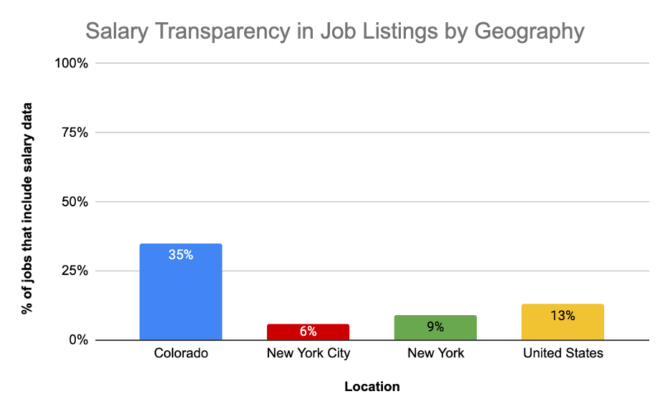
Despite Law, Just 35% of Colorado Job Listings Include Salary Data
Note to Readers: Since the time of publishing the percentage of Colorado job listings with salary information has changed. If you would like to know the latest percentage rate feel free to contact us.
In January 2021, a Colorado law took effect requiring employers with at least one employee in Colorado to post salaries in job descriptions. Nearly two years in, only 35 percent of listings in that state include salary information. But behind this problem for job seekers – and employers – is an opportunity for job boards to deepen their value.
Read on for a breakdown of the salary transparency trends we’re seeing, and why including salaries in job listings sets applicants and employers up for long-term success.
Job Listings with Salary Information Have Increased Overall (But Salary Transparency Is an Uphill Battle)
Here’s what we found after analyzing the seven million jobs in our JobsIndex:

Let’s start with the good news. The number of US job listings with salary information has gone up since April (from 7.8 percent to 13 percent) – a 67 percent increase in six months.
(Because we sourced this data from our JobsIndex, we can guarantee it’s updated, de-duplicated, and pulled straight from the websites or ATSes. One note: our data is slightly skewed toward larger employers, which means smaller employers might be underrepresented in these numbers.)
Here’s the not-so-good news. At first glance, it appears Colorado is doing well on salary transparency. But Colorado enacted its salary transparency law on January 1, 2021. That means employers have had nearly two years to comply – and only about a third of them have.
New York City’s transparency law takes effect November 1, and California’s legislature recently passed a measure to enact salary transparency. But if Colorado is any indication, even legally requiring companies to publish salaries may not have that big an impact on salary transparency.
Once the Default, Salary Concealment Is Becoming a Red Flag
Here’s the thing: not publishing salaries in job listings used to be the default. To a certain extent, it still is – but there’s a growing push for more transparency among those who value workplace equity. Why? Because the median annual wage for Black employees is nearly 30 percent lower than that of white employees. Women have historically made less than men.
Today’s job seekers, particularly Millennial and Gen Z workers, recognize these disparities and are increasingly making equity and inclusion baseline expectations for their employers.
The federal government recognizes the reality of wage disparities, too. As a way to combat wage inequality, the Obama administration signed a 2014 executive order specifically protecting workers’ right to discuss compensation with their colleagues. The OFCCP has been enforcing that ruling for the past eight years.
And yet, despite this growing awareness and the movement toward salary transparency, many employers are still resisting. In the year-plus since Colorado’s salary transparency law took effect, for example, most employers in the state haven’t complied. Some companies outside Colorado have banned Colorado residents from applying to open positions.
This… doesn’t look good.
This billboard by UK-based job board Otta explains one reason why (Figure 2).

Beyond the potential implications for “competitiveness” and equity, though, hiding salary information will, at the very least, deter some workers from applying: 62 percent of job seekers feel that salary data would persuade them to apply for open positions. Missing out on those applicants hurts employers, especially during our current labor shortage.
Companies are stronger when they’re diverse, equitable, and inclusive. It’s critical for employers to understand that salary transparency can help get them there.
How Job Boards Can Enhance Salary Transparency Efforts
One of the most important actions you can take as a job board is showing your clients how well job listings with salary information perform. This improved performance is a result of giving candidates what they want and giving the Google for Jobs algorithm what it wants: relevant information for job seekers.
Now let’s say you’ve convinced your client to include job listings with salary information. Great! But there’s still work for you to do. Your client may understand the value of salary information, but does your job board reflect that value? For example, are you…
- Putting salary information at the top of a listing?
- Creating a custom field for salaries?
- Enabling users to search by salary range?
And once a job seeker is thoroughly interested in a job listing, are you making it easy for them to apply?
These considerations and capabilities improve the user experience of your job board and reward the choice your client made by sharing salary information in the first place.
Heck, while you’re making these changes, use it as an opportunity to evaluate the other aspects of job listings on your site. Salary is an important factor, but job seekers also care about where the company is based and whether a position is hybrid or remote. The best job boards make all of this information easy to digest.
Including Salary Information in Job Listings Future-Proofs Your Job Board
Salary mandates should hit the mainstream in the next few years.
But it’s not just California, New York City, and Colorado that have passed salary transparency legislation. New York state’s salary transparency bill should take effect in early 2023. And multiple states and cities have recently enacted laws that increase salary transparency during the hiring process.
In the meantime, job boards can help employers use low salary disclosure rates to their advantage. Make it easy for them to highlight salary information while it’s still a differentiator and before it’s an expectation. Job seekers will take notice.
If you need help parsing salaries or formatting your listings, shoot us a message. We’ll even offer you a free month-long demo of our services.